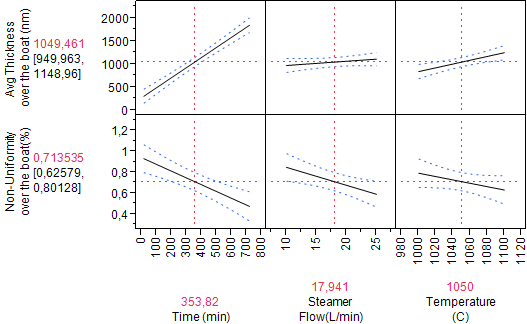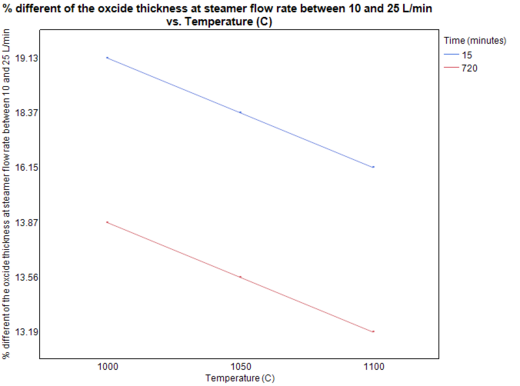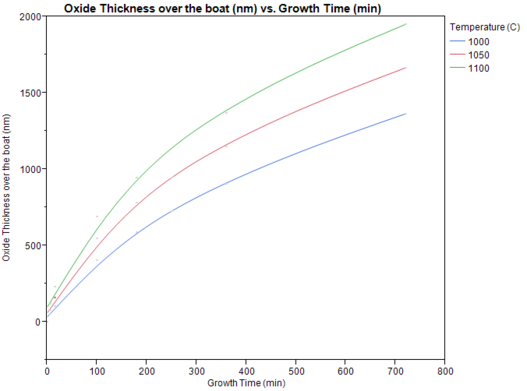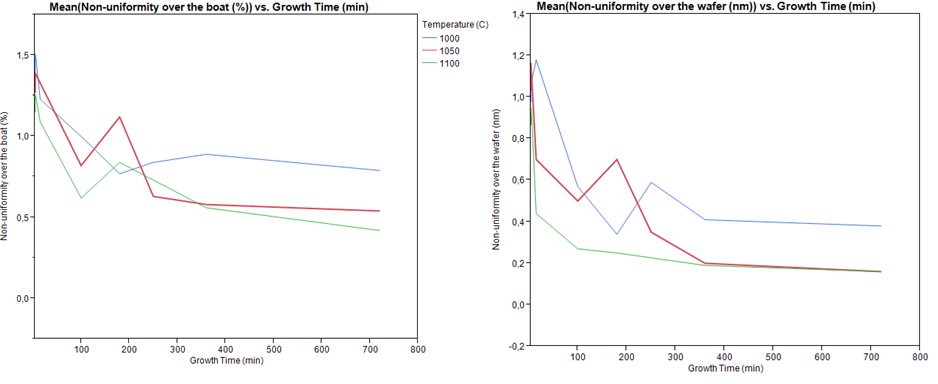Specific Process Knowledge/Thermal Process/Oxidation/Wet oxidation C1 furnace: Difference between revisions
No edit summary |
|||
| (31 intermediate revisions by 4 users not shown) | |||
| Line 1: | Line 1: | ||
= | '''Feedback to this page''': '''[mailto:labadviser@nanolab.dtu.dk?Subject=Feed%20back%20from%20page%20http://labadviser.nanolab.dtu.dk/index.php/Specific_Process_Knowledge/Thermal_Process/Oxidation/Wet_oxidation_C1_furnace click here]''' | ||
<i> Unless otherwise stated, this page is written by <b>DTU Nanolab internal</b></i> | |||
The | |||
The Anneal Oxide furnace (C1) is the used for annealing, and for dry and wet oxidation of 4" and 6" wafers. | |||
Water vapour for wet oxidation is generated by use of a steamer, which gives a very good oxide quality and uniformity. | |||
A new steamer has been installed in August 2024. The new steamer is from Bronkhorst and similar to the one on the E1. The old steamer was from Rasirc. | |||
<!-- ([[media:RASIRC_Steam_generator.pdf|RASIRC Steam Generator ]] )--> | |||
==Calculation for wet oxidation== | ==Calculation for wet oxidation== | ||
<b><span style="color:Red">The information is this section is not up-to-date, because it is based on oxidation results obtained with the old Rasirc steamer. This steamer has been replaced with a Bronkhorst steamer in August 2024, and this has slightly affected the oxidation rate for wet oxide.</span></b> | |||
The following links give an approximate oxide time/thickness based on prediction equations from the following experiments: | The following links give an approximate oxide time/thickness based on prediction equations from the following experiments: | ||
[[media:Calculation_for_Wet_oxidation_for_Anneal_Oxide(C1).xlsx|'''Calculation for wet oxidation''']] | [[media:Calculation_for_Wet_oxidation_for_Anneal_Oxide(C1)_version_2.xlsx|'''Calculation for wet oxidation''']] ''updated on June 2017'' | ||
==Test of the wet oxidation by steamer== | ==Test of the wet oxidation by steamer== | ||
<b><span style="color:Red">The information is this section is not up-to-date, because it is based on oxidation results obtained with the old Rasirc steamer. This steamer has been replaced with a Bronkhorst steamer in August 2024, and this has slightly affected the oxidation rate for wet oxide.</span></b> | |||
''by Patama Pholprasit @nanolab in October 2014'' | |||
''' | ''' | ||
''' | ''' | ||
| Line 19: | Line 33: | ||
''' | ''' | ||
To study the effect of the process temperature, growth time and steamer flow on the silicon dioxide | To study the effect of the process temperature, growth time and steamer flow rate on the silicon dioxide thickness and the percent of film non-uniformity. To form the prediction equations, which be able to calculate the growth time from the expected oxide thickness, or calculate the oxide thickness from the growth time. | ||
''' | ''' | ||
| Line 31: | Line 45: | ||
'''Temperature:''' 1000, 1050, 1100 C | '''Temperature:''' 1000, 1050, 1100 C | ||
'''Time:''' 15, 180, 360, 720 minutes | '''Growth Time:''' 15, 180, 360, 720 minutes | ||
'''Steamer Flow Rate:''' 10, 17.5, 25 L/min | '''Steamer Flow Rate:''' 10, 17.5, 25 L/min | ||
| Line 37: | Line 51: | ||
'''Anneal:''' Same as process temperature for 20 minutes with N<sub>2</sub>: 6 SLM | '''Anneal:''' Same as process temperature for 20 minutes with N<sub>2</sub>: 6 SLM | ||
'''Test Wafers:''' N-Type <100> No RCA Clean | '''Test Wafers:''' 4 inch silicon wafers, N-Type <100> No RCA Clean | ||
====Results (1)==== | ====Results (1)==== | ||
The figure 1 | The figure 1 shows that the silicon dioxide thickness over the boat is affected the most by growth time, temperature and steamer flow rate respectively. When the growth time, temperature and steamer flow rate increase, the silicon dioxide thickness also increases. Since the steamer flow has the least an effect to the silicon dioxide thickness, so the flow rate has been fixed at 10 liters per minutes in the furnace recipe. | ||
| Line 53: | Line 67: | ||
The percent of film non-uniformity over the boat most likely depends on the silicon dioxide thickness. The thicker silicon dioxide gives better film uniformity. The figure 1 | The percent of film non-uniformity over the boat most likely depends on the silicon dioxide thickness. The thicker silicon dioxide gives better film uniformity. The figure 1 shows that the percent of film non-uniformity over the boat decreases, when the growth time, steamer flow rate and the temperature increase. | ||
''' | ''' | ||
[[image:Steamer_process_develop_fig2.png|527 × 324 px|middle|The average silicon dioxide thickness and the percent of film non-uniformity over the wafer variation with | [[image:Steamer_process_develop_fig2.png|527 × 324 px|middle|The average silicon dioxide thickness and the percent of film non-uniformity over the wafer variation with growth time, steamer flow rate and temperature.]] | ||
''' | ''' | ||
'''Figure 2.''' The average silicon dioxide thickness and the percent of film non-uniformity over the wafer variation with | '''Figure 2.''' The average silicon dioxide thickness and the percent of film non-uniformity over the wafer variation with growth time, steamer flow rate and temperature. | ||
''' | ''' | ||
The effect of the steamer flow rate, | The effect of the steamer flow rate, growth time and temperature to the silicon dioxide thickness and to the percent of film non-uniformity over the wafer is quite similar with over the boat. But the percent of film non-uniformity over the boat is lower than over the boat, and the steamer flow has almost no an effect on the film uniformity. | ||
| Line 77: | Line 91: | ||
''' | ''' | ||
The figure 3 | The figure 3 shows that the percent different of silicon dioxide thickness deceases when the process temperature and growth time increase, which means that the steamer flow rate has less effect on the thicker silicon dioxide film. | ||
''' | ''' | ||
| Line 83: | Line 97: | ||
====Experimental setup (2) Steamer flow rate has been fixed at 10 liter/minutes==== | ====Experimental setup (2) Steamer flow rate has been fixed at 10 liter/minutes==== | ||
''' | ''' | ||
The steamer flow rate has been fixed at | The steamer flow rate has been fixed at 10 liter per minutes. The test was done in difference growth time and temperatures. | ||
'''Pressure:''' Atmosphere | '''Pressure:''' Atmosphere | ||
| Line 89: | Line 103: | ||
'''Temperature:''' 1000, 1050, 1100 C | '''Temperature:''' 1000, 1050, 1100 C | ||
'''Time:''' 0, 5, 15, 100, 180, 250, 360, 720 minutes | '''Growth Time:''' 0, 5, 15, 100, 180, 250, 360, 720 minutes | ||
'''Steamer Flow Rate:''' 10 L/min | '''Steamer Flow Rate:''' 10 L/min | ||
| Line 95: | Line 109: | ||
'''Anneal:''' Same as process temperature for 20 minutes with N<sub>2</sub>: 6 SLM | '''Anneal:''' Same as process temperature for 20 minutes with N<sub>2</sub>: 6 SLM | ||
'''Test Wafers:''' N-Type <100> No RCA Clean | '''Test Wafers:''' 4 inch Silicon wafers, N-Type <100> No RCA Clean | ||
====Results (2)==== | ====Results (2)==== | ||
Figure 4 shows the oxide thickness as a function of oxidation time in three process temperatures. The oxide grows faster at the higher temperature. The prediction equations of each process temperature can be form by this plots, which are based on this experiment in our specific furnaces and give more accurate results. [[media:Calculation_for_Wet_oxidation_for_Anneal_Oxide(C1).xlsx|'''Calculation for wet oxidation''']] | |||
''' | ''' | ||
| Line 115: | Line 132: | ||
''' | ''' | ||
From figure 5 | From figure 5 shows that the percent of film non-uniformity deceases when the growth time and temperature increase. From this experiment, show that the silicon dioxide has a very good uniformity. The percent of film non-uniformity is lower than 1.5 over the boat, and lower than 1.2 over the wafer. | ||
''' | ''' | ||
Latest revision as of 11:07, 30 August 2024
Feedback to this page: click here
Unless otherwise stated, this page is written by DTU Nanolab internal
The Anneal Oxide furnace (C1) is the used for annealing, and for dry and wet oxidation of 4" and 6" wafers.
Water vapour for wet oxidation is generated by use of a steamer, which gives a very good oxide quality and uniformity.
A new steamer has been installed in August 2024. The new steamer is from Bronkhorst and similar to the one on the E1. The old steamer was from Rasirc.
Calculation for wet oxidation
The information is this section is not up-to-date, because it is based on oxidation results obtained with the old Rasirc steamer. This steamer has been replaced with a Bronkhorst steamer in August 2024, and this has slightly affected the oxidation rate for wet oxide.
The following links give an approximate oxide time/thickness based on prediction equations from the following experiments:
Calculation for wet oxidation updated on June 2017
Test of the wet oxidation by steamer
The information is this section is not up-to-date, because it is based on oxidation results obtained with the old Rasirc steamer. This steamer has been replaced with a Bronkhorst steamer in August 2024, and this has slightly affected the oxidation rate for wet oxide.
by Patama Pholprasit @nanolab in October 2014
Purpose
To study the effect of the process temperature, growth time and steamer flow rate on the silicon dioxide thickness and the percent of film non-uniformity. To form the prediction equations, which be able to calculate the growth time from the expected oxide thickness, or calculate the oxide thickness from the growth time.
Experimental setup (1) Effect screening
The boat was fully filled with dummy wafers, and there are three tested wafers per run. The three tested wafers were placed at slot number 6, 15 and 24. The average silicon dioxide thickness and the percent of film non-uniformity over the boat were calculated form those three test wafers. The average silicon dioxide thickness and the percent of film non-uniformity over the wafer was calculated from the wafer slot no.15, which was placed in the middle of the boat. Silicon dioxide thickness was measured 5 points over the wafer by Filmtek.
Pressure: Atmosphere
Temperature: 1000, 1050, 1100 C
Growth Time: 15, 180, 360, 720 minutes
Steamer Flow Rate: 10, 17.5, 25 L/min
Anneal: Same as process temperature for 20 minutes with N2: 6 SLM
Test Wafers: 4 inch silicon wafers, N-Type <100> No RCA Clean
Results (1)
The figure 1 shows that the silicon dioxide thickness over the boat is affected the most by growth time, temperature and steamer flow rate respectively. When the growth time, temperature and steamer flow rate increase, the silicon dioxide thickness also increases. Since the steamer flow has the least an effect to the silicon dioxide thickness, so the flow rate has been fixed at 10 liters per minutes in the furnace recipe.
Figure 1. The average silicon dioxide thickness and the percent of film non-uniformity over the boat variation with process time, steamer flow rate and temperature.
The percent of film non-uniformity over the boat most likely depends on the silicon dioxide thickness. The thicker silicon dioxide gives better film uniformity. The figure 1 shows that the percent of film non-uniformity over the boat decreases, when the growth time, steamer flow rate and the temperature increase.
Figure 2. The average silicon dioxide thickness and the percent of film non-uniformity over the wafer variation with growth time, steamer flow rate and temperature.
The effect of the steamer flow rate, growth time and temperature to the silicon dioxide thickness and to the percent of film non-uniformity over the wafer is quite similar with over the boat. But the percent of film non-uniformity over the boat is lower than over the boat, and the steamer flow has almost no an effect on the film uniformity.
Figure 3. The percent different of the silicon dioxide thickness at the steamer flow rate at 10 and 25 l/min variation with temperature.
The figure 3 shows that the percent different of silicon dioxide thickness deceases when the process temperature and growth time increase, which means that the steamer flow rate has less effect on the thicker silicon dioxide film.
Experimental setup (2) Steamer flow rate has been fixed at 10 liter/minutes
The steamer flow rate has been fixed at 10 liter per minutes. The test was done in difference growth time and temperatures.
Pressure: Atmosphere
Temperature: 1000, 1050, 1100 C
Growth Time: 0, 5, 15, 100, 180, 250, 360, 720 minutes
Steamer Flow Rate: 10 L/min
Anneal: Same as process temperature for 20 minutes with N2: 6 SLM
Test Wafers: 4 inch Silicon wafers, N-Type <100> No RCA Clean
Results (2)
Figure 4 shows the oxide thickness as a function of oxidation time in three process temperatures. The oxide grows faster at the higher temperature. The prediction equations of each process temperature can be form by this plots, which are based on this experiment in our specific furnaces and give more accurate results. Calculation for wet oxidation
Figure 4. Silicon dioxide thickness variation with growth time (from 0 to 720 minutes) in different temperature.
Figure 5. The percent of film non-uniformity variation with growth time in different temperature. (left) Over the boat and (right) over the wafer
From figure 5 shows that the percent of film non-uniformity deceases when the growth time and temperature increase. From this experiment, show that the silicon dioxide has a very good uniformity. The percent of film non-uniformity is lower than 1.5 over the boat, and lower than 1.2 over the wafer.





